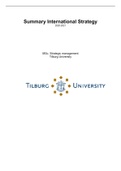Resume
Summary International Strategy (lectures, sheets & book)
- Cours
- Établissement
- Book
Detailed summary of the lectures, sheets and chapters of the book of the course International Strategy, for the master Strategic Management at Tilburg University. The articles are spread around the summary, as handled in the lectures.
[Montrer plus]





